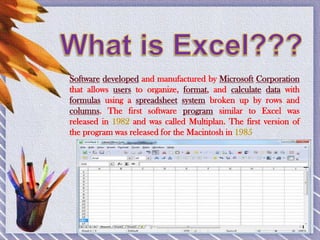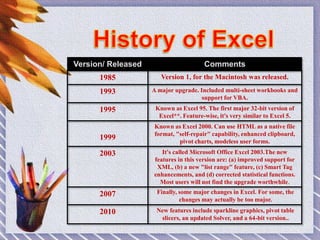Excel
- 1. Group Members : Harshala Thakur . Juanita Kasbe . Manisha Kunwar . Pranita Gaykar . Rajesh Mudaliyar .
- 2. Software developed and manufactured by Microsoft Corporation that allows users to organize, format, and calculate data with formulas using a spreadsheet system broken up by rows and columns. The first software program similar to Excel was released in 1982 and was called Multiplan. The first version of the program was released for the Macintosh in 1985
- 3. Version/ Released Comments 1985 Version 1, for the Macintosh was released. 1993 A major upgrade. Included multi-sheet workbooks and support for VBA. 1995 Known as Excel 95. The first major 32-bit version of Excel**. Feature-wise, it's very similar to Excel 5. 1999 Known as Excel 2000. Can use HTML as a native file format, "self-repair" capability, enhanced clipboard, pivot charts, modeless user forms. 2003 It's called Microsoft Office Excel 2003.The new features in this version are: (a) improved support for XML, (b) a new "list range" feature, (c) Smart Tag enhancements, and (d) corrected statistical functions. Most users will not find the upgrade worthwhile. 2007 Finally, some major changes in Excel. For some, the changes may actually be too major. 2010 New features include sparkline graphics, pivot table slicers, an updated Solver, and a 64-bit version..
- 4. 1) Functions:- MATHEMATICAL: Add, subtract, div, multiply. LOGICAL: average, sum, mode, product Tables:- Tables are created with different fields e.g. -name, age, address, roll no, so we add a table to fill these values. 2) Sorting and Filter:- In sorting we can sort our data and also filter our data so that repetitions will be removed. 3) Macros:- Macros are used for recording events for further use.4) Database:- We can add database from other sources with data feature. 5) Others :- Grouping, Data Validation, Clip Art, Hyperlink, Chart & Data Base 6)
- 5. Ms- Excel consist of workbooks. Within each workbook there is an infinite number of worksheets Each worksheet contains columns and rows. There are total 1048576 Rows and Total 16384 Columns 1048576 16384
- 12. Excel and Financial Data Data Types, Formulas, and Functions Excel's Other Uses
- 13. It is an Excel Function that is used within tables to help filter through large volumes of data and select the appropriate data based on given conditions. Meaning : Formula : =VLOOKUP(E7,Sheet3!F:G,2,FALSE) (lookup_value,table_array,col_index_num,range_lookup)
- 14. An Excel macro is a set of instructions that can be triggered by a keyboard shortcut, toolbar button or an icon in a spreadsheet. Macros are used to eliminate the need to repeat the steps of common tasks over and over.
- 15. A PivotTable report is an interactive way to quickly summarize large amounts of data. A PivotTable report is especially designed for: Querying large amounts of data in many user-friendly ways. Subtotaling and aggregating numeric data, summarizing data by categories and subcategories, and creating custom calculations and formulas Expanding and collapsing levels of data to focus your results, and drilling down to details from the summary data for areas of interest.
- 16. Moving rows to column or columns to rows (or "pivoting") to see different summaries of the source data Filtering, sorting, grouping, and conditionally formatting the most useful and interesting subset of data to enable you to focus on the information that you want. Presenting concise, attractive, and annotated online or printed reports.
- 17. To Press Start a formula = (EQUAL SIGN) Edit the active cell F2 Paste a name into a formula F3 Define a name CTRL+F3 Calculate all sheets in all open workbooks F9 Calculate the active worksheet SHIFT+F9 Insert the AutoSum formula ALT+= (EQUAL SIGN) Enter the date CTRL+; (SEMICOLON) Enter the time CTRL+SHIFT+: (COLON) Insert a hyperlink CTRL+K Copy the value from the cell above the active cell into the cell or the formula bar CTRL+SHIFT+" (QUOTATION MARK) Alternate between displaying cell values and displaying cell formulas CTRL+` (SINGLE LEFT QUOTATION MARK) Copy a formula from the cell above the active cell into the cell or the formula bar CTRL+' (APOSTROPHE) Insert the argument names and parentheses for a function, after you type a valid function name in a formula CTRL+SHIFT+A
- 18. Function Key SHIFT CTRL ALT CTRL+SHIFT ALT+SHIFT F1 Display Help or the Office Assistant What's This? Insert a chart sheet Insert a new worksheet F2 Edit the active cell Edit a cell comment Save As command Save command F3 Paste a name into a formula Paste a function into a formula Define a name Create names by using row and column labels F4 Repeat the last action Repeat the last Find (Find Next) Close the window Exit F5 Go To Display the Find dialog box Restore the window size F6 Move to the next pane Move to the previous pane Move to the next workbook window Move to the previous workbook window F7 Spelling command Move the window F8 Extend a selection Add to the selection Resize the window Display the Macro dialog box F9 Calculate all sheets in all open workbooks Calculate the active worksheet Minimize the workbook F10 Make the menu bar active Display a shortcut menu (right click) Maximize or restore the workbook window F11 Create a chart Insert a new worksheet Insert a Microsoft Excel 4.0 macro sheet Display Visual Basic Editor F12 Save As command Save command Open command Print command



















